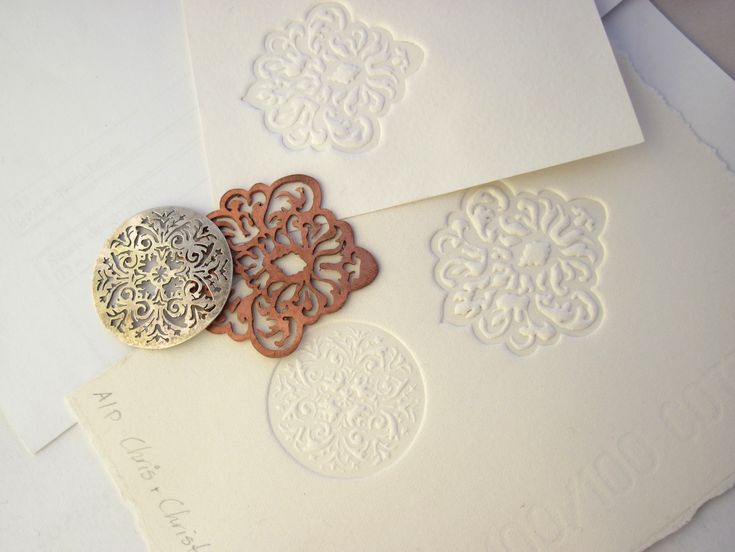Embossing
Embossing is a captivating printmaking technique that involves creating a raised or recessed design on a material’s surface, giving it a three-dimensional quality. Used in everything from fine art to commercial applications like business cards and packaging, the technique offers both tactile and visual appeal. So, let’s dive into the history, the step-by-step process, the required materials, and various techniques used by artists and designers alike.
History
The technique has ancient roots, with early examples dating back to Ancient Egypt, where artisans would press images and symbols into metalwork, leather, and fabric. This technique spread across different cultures and adapted over time, with advancements in materials and technology. During the Middle Ages, the technique gained popularity in Europe, especially for creating decorative details on books, leather goods, and metal artefacts. In the 19th and 20th centuries, it became a staple in fine printmaking and commercial printing, valued for adding an elegant touch to stationery, packaging, and artwork.
Today, it is a popular technique in both artistic and commercial printmaking. With modern tools and digital technologies, artists and designers can create intricate embossed designs with precision and consistency.
Materials
The technique can be performed on a variety of materials. Here’s a list of the essential materials and tools you’ll need:
- Substrate: Commonly paper, but it can be done on leather, metal, wood, and some fabrics.
- Embossing Plate or Die: Typically made from metal (like brass or copper), dies to create the raised or recessed design on the substrate.
- Press or Roller: A press is essential for applying even pressure to transfer the design onto the material.
- Registration Guides: These are used to ensure that the design is aligned correctly.
- Stylus or Embossing Tools: These tools are handy for manually embossing or adding details by hand.
- Heat and Pressure: Some techniques require controlled heat and pressure to transfer the design effectively.
Process of Embossing in Printmaking
Step 1: Designing the Template
- First, create a template or design for the embossing plate. This design can be created digitally or hand-drawn. For printmaking, high-contrast, bold shapes work best as they translate well into the raised form.
Step 2: Preparing the Plate
- Using the design, prepare an embossing plate or die. The die can be etched into metal or created from other materials like plastic or wood, depending on the project’s detail and desired effect. The plate’s design will be the inverse of the desired embossed image.
Step 3: Positioning the Paper or Material
- Carefully align your paper or substrate on the plate. Ensure that the material is properly centred and aligned to avoid any misprints.
Step 4: Running the Plate Through the Press
- Place the plate and the material between the press rollers or on the press bed. Gently apply pressure, ensuring that it’s even across the entire plate. If you’re using a hand-held embossing tool, press firmly to transfer the design.
Step 5: Releasing and Reviewing the Emboss
- Carefully remove the material from the plate and inspect the emboss. Make sure the design is even and clear. If not, adjust the pressure or reposition and try again.
Step 6: Additional Detailing (Optional)
- For added texture, some artists use a stylus to create more intricate details on the raised design. Alternatively, you could apply inks, paints, or foil to enhance the embossed effect.

Techniques of Embossing
Blind Embossing
Blind embossing is when you emboss without using any ink or foil. It relies purely on the raised design to create visual interest. This is often used in fine art prints, business cards, and letterheads.
Registered Embossing
Registered embossing aligns the embossed design with printed images or text. This technique is common in packaging, where embossed logos or images add a premium feel to products.
Debossing
The opposite of embossing, debossing presses the design down into the material instead of raising it. It’s used for an engraved look and is popular on leather, metal, and paper.
Foil Embossing
Foil embossing adds metallic or pigmented foils to the embossed areas, combining shine with depth. This technique requires heat to transfer the foil onto the raised design, creating an eye-catching effect that’s popular in luxury branding.
Multi-Level Embossing
This technique uses dies with various depth levels, creating a design with multiple raised sections. Multi-level embossing is intricate and requires precision, making it popular for high-end packaging and detailed art prints.
It is a time-honoured technique in printmaking that brings a beautiful, tactile quality to printed pieces. Whether it’s through blind embossing, foil embossing, or intricate multi-level designs, embossing adds depth and a sense of luxury. With the right materials, careful alignment, and a well-crafted embossing plate, artists and designers can elevate their projects, creating memorable, textured prints that engage the senses.